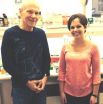(Press-News.org) People and spaces, the tragedy of commonsense morality, myths about meaning of life, and remaking love were four themes at the Society for Personality and Social Psychology (SPSP) conference in Austin. Researchers presented new work, showing how psychology reaches into our everyday lives. Video from four of these talks is now available online.
Highlights include:
Sam Gosling of the University of Texas-Austin described how the link between our emotions and spaces is is inseparable. As such, our spaces say a lot about us. In new work, Gosling and colleagues identified the emotions and traits that people systemically invoke to create their home spaces. Restoration, kinship, stimulation, productivity , storage, and intimacy are the six organizing constructs their found. Each of those words has many sub-traits that describe how people want to evoke a particular ambiance in a particular space.
In his study of about 200 people, for example, 60% of participants chose one of the following words to describe the ambiance they most wanted for their kitchens: organization, family, productivity, abundance, and togetherness. And they found that 62% of participants wanted their bedrooms to evoke a sense of romance, comfort, relaxation, love, and privacy. Watch the video: http://www.youtube.com/watch?v=88tcUBZRbwk
Barbara Fredrickson of the University of North Carolina discussed her new research that shows how love affects us not only psychologically but also physiologically. She pointed to vital, fleeting "micro-moments" in which we connect with others. The more you experience micro-moments, the more it will change you for the better.
Take the case of the vagus nerve, which, in part, regulates our emotions and is responsible for associated changes in our heartbeat. The nerve calms our racing hearts after a fight and helps keep our hearts on a healthy rhythm. It affects the body's ability to regulate glucose and our biological capacity for connection, Fredrickson said. Her research has found that increasing micro-moments boosts the functioning of the vagus nerve. Watch the video: http://www.youtube.com/watch?v=HsGlcNFB-pM
Joshua Greene of Harvard talked about how moral questions can be broken down into "me vs. us" and "us vs. them." When we're thinking about "me vs. us," our intuitions are good. We automatically tune into guilt, gratitude, and empathy to lead us to cooperate with others. But when it comes to questions of "we vs. us," we run into clashes between communities and how we perceive fairness. The very forces that bring us closer together also build group loyalties that are difficult for us to break free of. To think about the greater good, we have to switch into "manual mode." Watch the video: http://www.youtube.com/watch?v=9reBdFoIdY0
Laura King of the University of Missouri discussed five myths of meaning in life, pointing toward recent work that shows that, contrary to popular belief, meaning in life is common. Easy, simple thing can bring us meaning, King said, like having a good mood, making social connections, and having routine associations with our environments. Realizing that our lives are indeed meaningful has manifold benefits for quality of life, satisfaction, and health. Watch the video: http://www.youtube.com/watch?v=sYHMNJ1Ucjc
INFORMATION:
Gosling, Frederickson, Greene, and King presented their work on Feb. 14, 2014, at the SPSP conference in Austin. More than 3,500 scientists attended the conference in Austin from Feb. 13-15.
SPSP promotes scientific research that explores how people think, behave, feel, and interact. With more than 6,000 members, the Society is the largest organization of social and personality psychologists in the world.
Personality and spaces, remaking love, meaning in life, and commonsense morality
Psychology in action
2014-02-18
ELSE PRESS RELEASES FROM THIS DATE:
One-quarter of high risk patients denied anticoagulation after AF ablation
2014-02-18
Sophia Antipolis, 18 February 2014: One-quarter of high risk patients do not receive anticoagulants after ablation of atrial fibrillation (AF), according to the latest survey of European practice.
The EORP Atrial Fibrillation Ablation Pilot Study, conducted by the European Heart Rhythm Association (EHRA) of the European Society of Cardiology (ESC), reveals that 65% of patients were taking anticoagulants one year after ablation of AF.1 But up to 25% of patients at high risk of stroke (defined as a CHA2DS2-VASc score >1) were not taking any anticoagulant drug. And around ...
A new system accelerates verification of printed electronic documents
2014-02-18
This news release is available in Spanish. Researchers at the Universidad Carlos III in Madrid have designed a system that speeds up online administrative procedures by automatically verifying and validating printed electronic documents, a process that had been done manually up until now.
With the law known as Ley 11/2007, regarding citizens' electronic access to public services, going into effect, electronic documents have gained full legal validity. When a document of this type is printed out, it must be accompanied by its Código Seguro de Verificación (CSV- Secure ...
Parents are not more likely to split up if mothers earn more than fathers
2014-02-18
Couples with young children are as likely to stay together if the mother is the main breadwinner rather than the father, new research shows.
A paper published in the journal Sociology today [Tuesday 18 February 2014] says the relationships of parents are in some cases more stable if the mother earns more than the father.
Dr Shireen Kanji, of the University of Leicester School of Management, and Dr Pia Schober, of the German Institute for Economic Research, Berlin, examined survey data on 3,944 British couples as their first child aged from eight months to seven years. ...
Food & moods
2014-02-18
Emotional eating is something we're all familiar with. Maybe you had had a rough week at work and all you want on Friday night is to plop down and watch a movie with a giant bowl of buttery popcorn. Maybe you're a student stressed about a big exam and you're munching on candy as you study. Or maybe your child's birthday party is coming up and you've bought an ice cream cake to serve a small army to celebrate. Happy or sad, up or down, there's a plethora of media in the world that tells us our moods often dictate the foods we choose to eat.
More recent studies, though, ...
New treatment proposed to prevent intestinal inflammation in cancer patients
2014-02-18
Jerusalem, Feb. 18, 2014 – Experimental work pointing to a therapy for alleviating mucositis -- a common, severe side effect of chemotherapy and irradiation of cancer patients or patients prepared for bone marrow transplantation – has been achieved by an international team of researchers from the US and Israel headed by scientists at the Hebrew University of Jerusalem.
Mucositis is a strong inflammatory reaction of the mucosal lining of the digestive system, particularly the gut. Mucositis is often a major reason for premature suspension of anti-cancer therapy. As ...
Increase in Arctic cyclones is linked to climate change, new study shows
2014-02-18
Winter in the Arctic is not only cold and dark, it is also storm season when hurricane-like cyclones traverse the northern waters from Iceland to Alaska. These cyclones are characterized by strong localized drops in sea level pressure, and as Arctic-wide decreases in sea level pressure are one of the expected results of climate change, this could increase extreme Arctic cyclone activity, including powerful storms in the spring and fall.
A new study in Geophysical Research Letters uses historical climate model simulations to demonstrate that there has been an Arctic-wide ...
Saving Sochi's slopes: How artificial snow is made
2014-02-18
WASHINGTON, Feb. 18, 2014 — In what may be the warmest Winter Olympics on record, Sochi looks more like SoCal by the day. With few real snowflakes around to blanket Sochi's slopes, the latest episode of the American Chemical Society's Reactions YouTube series explains how science keeps the Winter Olympics alive with artificial snow. The video is available at http://youtu.be/ftMFMlk6FlA.
Producing artificial snow isn't as simple as grinding up big blocks of ice and spraying it on the slopes. Sochi's artificial snow guns — cannons that fire fake snow 20 to 30 feet in ...
Workers, get up and move
2014-02-18
Are you active at your job? If you're like most workers, you probably aren't. And the consequences could be deadly.
A team of researchers at the University of Iowa measured physical activity in police, whose jobs are presumably predicated on movement. Yet the group found that police officers burn as much energy on the job as someone sitting while holding a baby or washing dishes.
"We find that police work is primarily sedentary," explains Sandra Ramey, assistant professor in the UI College of Nursing. "The public view, how the media portray it on shows like 'Hawaii ...
When a black hole shreds a star, a bright flare tells the story
2014-02-18
Enrico Ramirez-Ruiz uses computer simulations to explore the universe's most violent events, so when the first detailed observations of a star being ripped apart by a black hole were reported in 2012 (Gezari et al., Nature), he was eager to compare the data with his simulations. He was also highly skeptical of one of the published conclusions: that the disrupted star was a rare helium star.
"I was sure it was a normal hydrogen star and we were just not understanding what's going on," said Ramirez-Ruiz, a professor of astronomy and astrophysics at the University of California, ...
Study points out inequalities in prescribing blood pressure meds
2014-02-18
Primary care doctors are not quick to prescribe antihypertensive medication to young people even after an average of 20 months of high blood pressure. Young adults who are white, male, not on Medicaid and not frequent clinic visitors are especially less likely to receive medication. These are the results of a study¹ by a research team at the University of Wisconsin School of Medicine and Public Health in the United States led by Heather Johnson. It appears in the Journal of General Internal Medicine², published by Springer.
One in every 10 Americans between the ages of ...
LAST 30 PRESS RELEASES:
The Journal of Nuclear Medicine Ahead-of-Print Tip Sheet: January 2, 2026
Delayed or absent first dose of measles, mumps, and rubella vaccination
Trends in US preterm birth rates by household income and race and ethnicity
Study identifies potential biomarker linked to progression and brain inflammation in multiple sclerosis
Many mothers in Norway do not show up for postnatal check-ups
Researchers want to find out why quick clay is so unstable
Superradiant spins show teamwork at the quantum scale
Cleveland Clinic Research links tumor bacteria to immunotherapy resistance in head and neck cancer
First Editorial of 2026: Resisting AI slop
Joint ground- and space-based observations reveal Saturn-mass rogue planet
Inheritable genetic variant offers protection against blood cancer risk and progression
Pigs settled Pacific islands alongside early human voyagers
A Coral reef’s daily pulse reshapes microbes in surrounding waters
EAST Tokamak experiments exceed plasma density limit, offering new approach to fusion ignition
Groundbreaking discovery reveals Africa’s oldest cremation pyre and complex ritual practices
First breathing ‘lung-on-chip’ developed using genetically identical cells
How people moved pigs across the Pacific
Interaction of climate change and human activity and its impact on plant diversity in Qinghai-Tibet plateau
From addressing uncertainty to national strategy: an interpretation of Professor Lim Siong Guan’s views
Clinical trials on AI language model use in digestive healthcare
Scientists improve robotic visual–inertial trajectory localization accuracy using cross-modal interaction and selection techniques
Correlation between cancer cachexia and immune-related adverse events in HCC
Human adipose tissue: a new source for functional organoids
Metro lines double as freight highways during off-peak hours, Beijing study shows
Biomedical functions and applications of nanomaterials in tumor diagnosis and treatment: perspectives from ophthalmic oncology
3D imaging unveils how passivation improves perovskite solar cell performance
Enriching framework Al sites in 8-membered rings of Cu-SSZ-39 zeolite to enhance low-temperature ammonia selective catalytic reduction performance
AI-powered RNA drug development: a new frontier in therapeutics
Decoupling the HOR enhancement on PtRu: Dynamically matching interfacial water to reaction coordinates
Sulfur isn’t poisonous when it synergistically acts with phosphine in olefins hydroformylation
[Press-News.org] Personality and spaces, remaking love, meaning in life, and commonsense moralityPsychology in action



